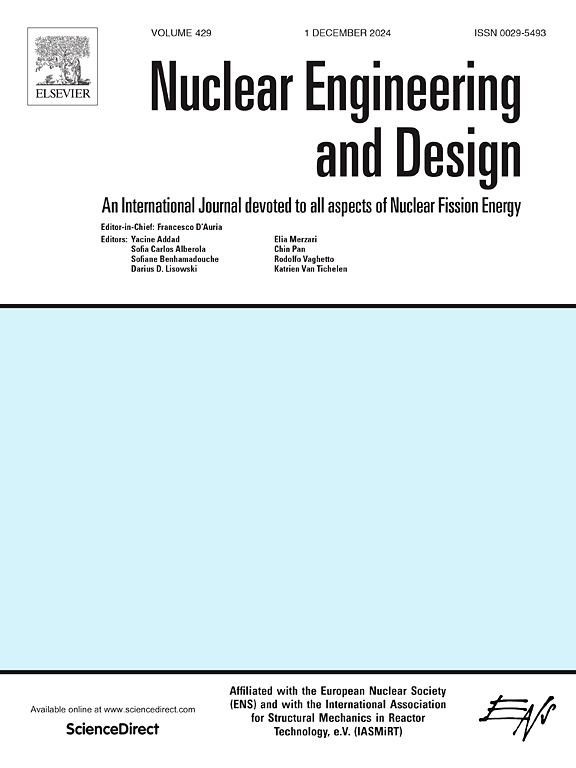A reverse scatter correction method for CT images of nuclear graphite components
IF 1.9
3区 工程技术
Q1 NUCLEAR SCIENCE & TECHNOLOGY
引用次数: 0
Abstract
The structural integrity of high-temperature gas-cooled reactors (HTGRs) is reliant on over 3000 carbon/graphite components, each of which necessitates computed tomography (CT) scanning for non-destructive testing prior to deployment, as stipulated by the reactor’s technical specifications. Despite the critical role of CT scans, they are frequently marred by significant scatter artifacts due to the detection of scattered photons, which compromises image uniformity and diminishes the system’s ability to detect defects. Our research presents a novel inverse scatter photon prediction model that addresses the shortcomings of traditional models by utilizing empirical data and the inherent properties of nuclear graphite/carbon components. This method begins by mapping and subtracting the transmitted photons from the projection data, followed by estimating the scattered photon distribution based on their low-frequency characteristics. The experimental results confirm that our method not only surpasses Monte-Carlo simulations and machine learning in reducing scatter artifacts but also meets the efficiency requirements for online detection. Our quantitative analyses indicate that our approach achieves the highest Defects Recognition Performance (DRP) value, which underscores a notable enhancement in the system’s ability to detect defects. We are confident that our findings will significantly enhance the defect detection capabilities of the CT scanning system, thereby contributing to the overall safety and reliability of HTGR operations.
核石墨组分CT图像的反向散射校正方法
高温气冷堆(htgr)的结构完整性依赖于3000多个碳/石墨组件,按照反应堆技术规范的规定,在部署之前,每个组件都需要进行计算机断层扫描(CT)的无损检测。尽管CT扫描具有关键作用,但由于检测到散射光子,它们经常被显著的散射伪影所破坏,这损害了图像的均匀性并降低了系统检测缺陷的能力。本研究利用经验数据和核石墨/碳组分的固有特性,提出了一种新的反向散射光子预测模型,解决了传统模型的不足。该方法首先从投影数据中映射和减去透射光子,然后根据其低频特性估计散射光子的分布。实验结果表明,该方法不仅在减少散射伪影方面优于蒙特卡罗模拟和机器学习,而且能够满足在线检测的效率要求。我们的定量分析表明我们的方法达到了最高的缺陷识别性能(DRP)值,这强调了系统检测缺陷能力的显著增强。我们相信,我们的发现将显著提高CT扫描系统的缺陷检测能力,从而有助于HTGR操作的整体安全性和可靠性。
本文章由计算机程序翻译,如有差异,请以英文原文为准。
求助全文
约1分钟内获得全文
求助全文
来源期刊

Nuclear Engineering and Design
工程技术-核科学技术
CiteScore
3.40
自引率
11.80%
发文量
377
审稿时长
5 months
期刊介绍:
Nuclear Engineering and Design covers the wide range of disciplines involved in the engineering, design, safety and construction of nuclear fission reactors. The Editors welcome papers both on applied and innovative aspects and developments in nuclear science and technology.
Fundamentals of Reactor Design include:
• Thermal-Hydraulics and Core Physics
• Safety Analysis, Risk Assessment (PSA)
• Structural and Mechanical Engineering
• Materials Science
• Fuel Behavior and Design
• Structural Plant Design
• Engineering of Reactor Components
• Experiments
Aspects beyond fundamentals of Reactor Design covered:
• Accident Mitigation Measures
• Reactor Control Systems
• Licensing Issues
• Safeguard Engineering
• Economy of Plants
• Reprocessing / Waste Disposal
• Applications of Nuclear Energy
• Maintenance
• Decommissioning
Papers on new reactor ideas and developments (Generation IV reactors) such as inherently safe modular HTRs, High Performance LWRs/HWRs and LMFBs/GFR will be considered; Actinide Burners, Accelerator Driven Systems, Energy Amplifiers and other special designs of power and research reactors and their applications are also encouraged.
 求助内容:
求助内容: 应助结果提醒方式:
应助结果提醒方式:


